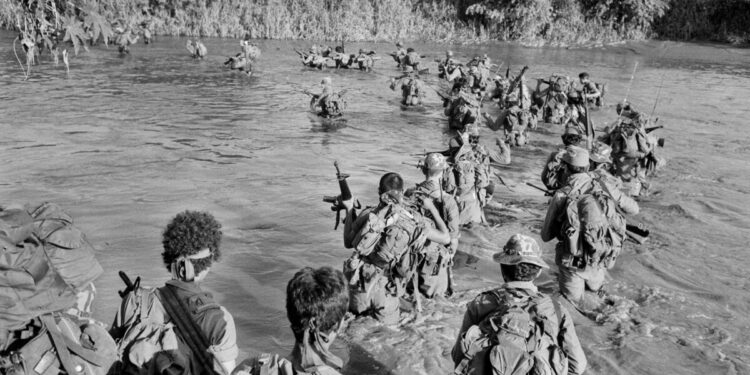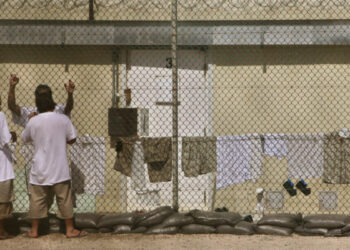El Salvador’s civil war, which lasted from 1980 to 1992 and killed more than 80,000 people, may seem eons ago. But its effects linger in the country’s infamous gang violence and its authoritarian government.
Robert Nickelsberg was among the first and best American photojournalists to chronicle El Salvador’s cold-war carnage — and the U.S.’s complicity in it.
He’s now collected his striking black-and-white photos from those years in a new book, Legacy of Lies: El Salvador 1981-84, which he’ll present next week in Miami, including Florida International University.
I had the privilege years ago to work with Nickelsberg, who’s also won awards for his Afghanistan photography. He spoke with me from his home in New York about the book, the painful if sometimes hopeful memories its images evoke — and their undoubted relevance four decades later.
Nickelsberg says the spark for the book came from his wife, former Time Magazine photo editor Crary Pullen, who got tired of walking around the box of old El Salvador film he had stored in a hallway of their home in Brooklyn.
“She finally said, ‘You’ve got to do something with that,” says Nickelsberg, who in the 1980s was a contract photographer for Time.
“And when I opened it up I saw that it was actually an amazing set of images — many of which I’d never seen before because, remember, back then we sent all our film unprocessed to the magazine editors in New York.”
The negatives and contact sheets “yes, jarred my memory,” Nickelsberg says.
But in Legacy of Lies, he also writes that “El Salvador continues to pay the price” for its horrible 1980s conflict. And that reality — that in the decades since, El Salvador’s been choked by one of the world’s highest homicide rates, and that it’s again under the thumb of authoritarian rule — was an impetus for the book.
READ MORE: Photographic Memory: Gentile’s ‘Wait for Me’ recalls 1980s Central American conflicts
“I had also covered the Salvadoran gangs in U.S. cities like Los Angeles in 2006 — to witness what a lot of young Salvadoran kids, who were maybe two or three years old when they first came to the United States to get out of the civil war, had grown into,'” he says.
“And what I saw was very, very violent. So I could see another part of the legacy of El Salvador that people need to be reminded about today, there and here.”
I asked Nickelsberg how haunting the Legacy of Lies photos were to revisit — if only because many of them remind us that El Salvador’s civil war gave us the term “right-wing death squads,” the hitmen who served the army and the oligarchy and murdered anyone suspected of supporting the left-wing guerrillas.
In the book, for example, Nickelsberg notes that photographers like himself could look for vultures circling overhead each morning to find the death squads’ latest victims. Was he prepared for that, I asked, when he first went to El Salvador?
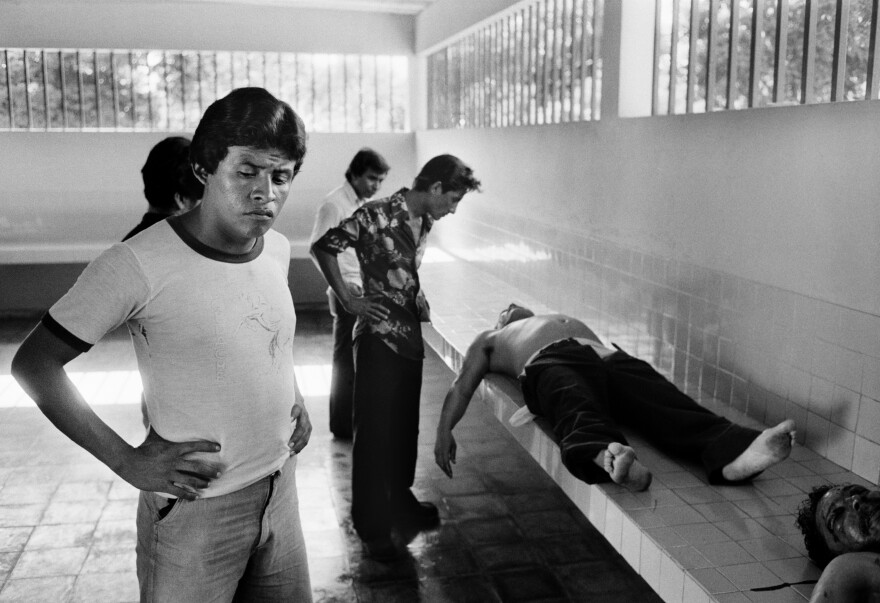
Robert Nickelsberg
/
Legacy of Lies
Salvadorans examine corpses in the city morgue in La Libertad, El Salvador, Aug. 10, 1984. The victims had been tortured and executed at close range, shot in the face, methods used by right-wing death squads during the civil war.
“Well, you have to take on a different meaning of the word ‘normal,'” he says.
“Vultures actually weren’t the first thing we looked for. It was victim dumping sites that were scattered around the capital, San Salvador, particularly near the slums or periphery of the city.
“In a conflict zone, seeing these levels of violence, and the chaos it causes within a society — you have to be able to figure it out rationally, and put your emotions aside very often.”
“But yes, it accumulates inside you.”
At the same time, many other Legacy of Lies photos are visually beautiful or striking in ways that will remind people of the dignity of ordinary Salvadorans — as well as the causes of the horrible conflict they were trapped in.
One of a religious procession, for example, exudes an almost dreamlike quality — while another, of an elderly coffee plantation worker struggling with an overweight bag of harvested beans, seems to capture the root injustices that led to El Salvador’s guerrilla uprising.
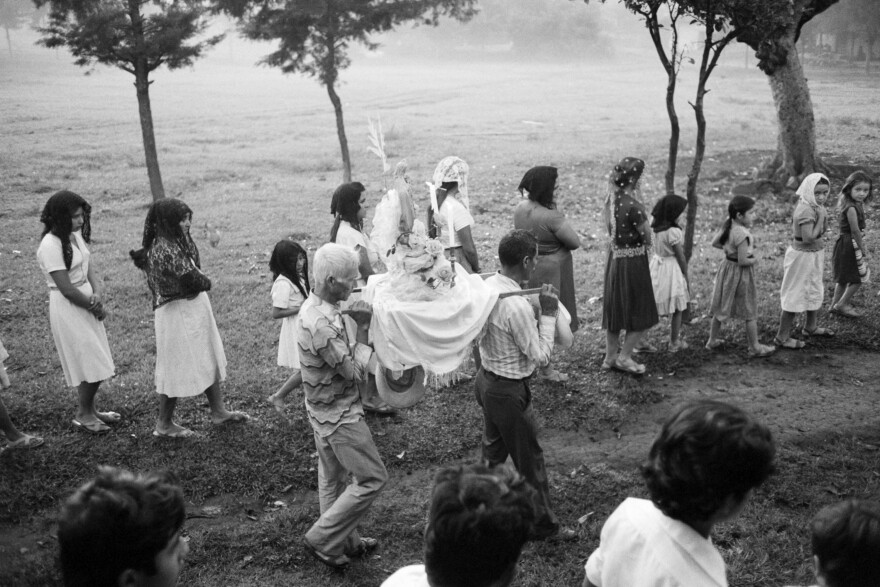
Robert Nickelsberg
/
Legacy of Lies
An altar with a statue of Jesus Christ is carried in a religious procession through the streets in Perquín, Morazán department, El Salvador, October 23, 1983.
“When I initially went to Central America, it was to illustrate U.S. foreign policy,” says Nickelsberg, a Vermont native.
“But first I had to understand the narrative of the Salvadorans — because I found that the concerns of the people at that time were overlooked by U.S. policy and shoved aside.”
El Salvador, in fact, had become one of the Cold War’s many proxy conflicts, and the U.S. got involved there on the side of the abusive oligarchy and military, whose officers and soldiers it helped train and arm.
Not that the leftist guerrillas were saints, either. But Nickelsberg writes, “What we captured graphically contradicted what the Reagan Administration claimed was occurring in El Salvador.” Hence the book’s title.
“U.S. officials would testify that Salvadoran human rights were getting better, but there was no possible way — and I had pictures to prove that.”
Robert Nickelsberg
“It seemed every month, every six months, particularly with the [U.S.] House and Senate hearings on Salvadoran human rights and approving the military aid, State Department officials would testify that things are getting better.”
“And on the ground, there was no possible way that things were getting better — and I had pictures to prove that. We would just shake our heads and say, ‘What — what are they thinking?'”
“The U.S. knew fully that there was no check on the [Salvadoran] death squads and the security forces.”
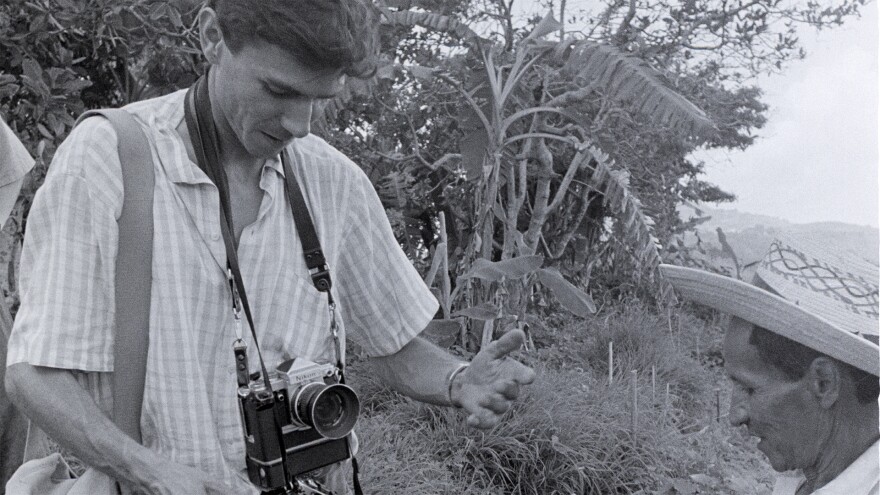
Courtesy Robert Nickelsberg
Robert Nickelsberg photographing a campesino in El Salvador in 1983.
“They thought they could make democracy trickle down through a Salvadoran elite that in reality could have cared less — that shared none of those values and had no intention of accommodating them.”
Legacy of Lies also contains essays from some of the most respected correspondents covering El Salvador at that time — including Alma Guillermoprieto, who for the Washington Post helped uncover the horrific 1981 El Mozote massacre of a thousand Salvadorans villagers by the infamous Atlacatl army batallion.
“It does come back to haunt people,” Nickelsberg says. “And if they can put those emotions and facts together again, that’s what you get in the strong essays that the book has.”
Another essayist is Salvadoran journalist Carlos Dada, whose family was exiled in Mexico during the civil war. Today, as founder of the digital newspaper El Faro, Dada again finds himself in exile for confronting the dictatorial Bukele, who this year secured a second presidential term in violation of the constitution.
It’s a reminder that Nickelsberg’s book isn’t just a remembrance of El Salvador’s past, but a warning about its present and future, and the U.S.’s role in it.
If you go:
Robert Nickelsberg will present Legacy of Lies: El Salvador 1981-84
WHERE: Florida International University at the Maurice Ferré Institute of the Green School of International and Public Affairs (2nd floor)
WHEN: Tuesday, Oct. 1, at 3 pm
More info here.
Source link : http://www.bing.com/news/apiclick.aspx?ref=FexRss&aid=&tid=66f47455199c4f36b299cb340c5b1027&url=https%3A%2F%2Fwww.wlrn.org%2Famericas%2F2024-09-25%2Flegacy-of-lies-recalls-the-horrors-of-1980s-el-salvador-that-linger-today&c=1740159461198657481&mkt=en-us
Author :
Publish date : 2024-09-25 09:23:00
Copyright for syndicated content belongs to the linked Source.

